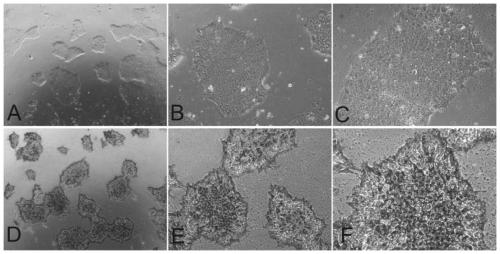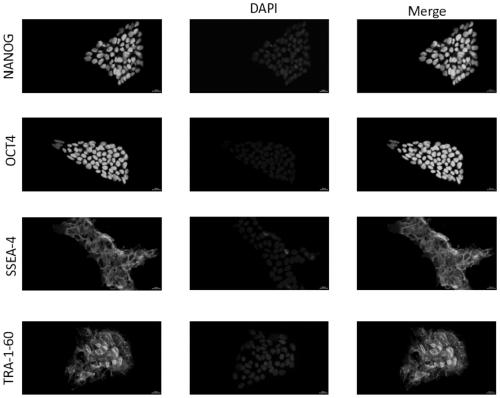Novel ips cell inducing method
A cell and inducer technology, applied in the field of cell engineering, can solve the problems of low reprogramming efficiency and low stemness of iPS stem cells
- Summary
- Abstract
- Description
- Claims
- Application Information
AI Technical Summary
Problems solved by technology
Method used
Image
Examples
Embodiment 1
[0054] Embodiment 1, preparation of reprogramming factor carrier
[0055] Eight reprogramming factors were used in reprogramming: Oct3 / 4, Klf4, Sox2, P53, L-Myc, Lin28, RARg, Lrh-1, and the expression vector was episomal vector.
[0056] The expression vector is an episomal vector, specifically pCXWB, purchased from addgene.
[0057]Reprogramming factor vector A is a vector obtained by inserting fragment A between the pCXWB vector ECoRI restriction sites, expressing Oct3 / 4, Klf4, Sox2, P53, L-Myc, Lin28 genes;
[0058] The nucleotide sequence of fragment A consists of Oct3 / 4 gene sequence (sequence 1), T2A nucleotide sequence (sequence 9), Klf4 gene sequence (sequence 2), P2A nucleotide sequence (sequence 10), Sox2 gene sequence (SEQ ID NO: 3), T2A nucleotide sequence (SEQ ID NO: 9), P53 gene sequence (SEQ ID NO: 6), IRES sequence (SEQ ID NO: 12), L-Myc gene sequence (SEQ ID NO: 4), E2A nucleotide sequence (SEQ ID NO: 11) and Lin28 gene sequence (sequence 5), and each sequen...
Embodiment 2
[0062] Example 2, reprogramming of iPS pluripotent stem cells
[0063] 1. Reprogramming of iPS pluripotent stem cells
[0064] 1. Culture human skin fibroblasts (purchased from promocell, article number: C-12302);
[0065] 2. Transfer the reprogramming factor carrier A, reprogramming factor carrier B and EBNA1 (purchased from addgene, Plasmid#41857) obtained in Example 1 into isolated human skin fibroblasts or peripheral blood at a mass ratio of 1:1:1 In monocytes, cells expressing reprogramming factors are obtained; details are as follows:
[0066] a. The fibroblasts obtained in the above step 1 cover about 90% of the bottom of the T25 flask;
[0067] b. The day before the experiment, spread Matrigel on a 6-well plate. Before electroporation, 2 mL of fibroblast culture medium was added to each well in advance.
[0068] c. Digest the cells with Trypsin-EDTA (0.05%), neutralize, centrifuge, and suck up the supernatant. Select a 100uL system electroporation kit and resuspend...
PUM
 Login to View More
Login to View More Abstract
Description
Claims
Application Information
 Login to View More
Login to View More - R&D
- Intellectual Property
- Life Sciences
- Materials
- Tech Scout
- Unparalleled Data Quality
- Higher Quality Content
- 60% Fewer Hallucinations
Browse by: Latest US Patents, China's latest patents, Technical Efficacy Thesaurus, Application Domain, Technology Topic, Popular Technical Reports.
© 2025 PatSnap. All rights reserved.Legal|Privacy policy|Modern Slavery Act Transparency Statement|Sitemap|About US| Contact US: help@patsnap.com



